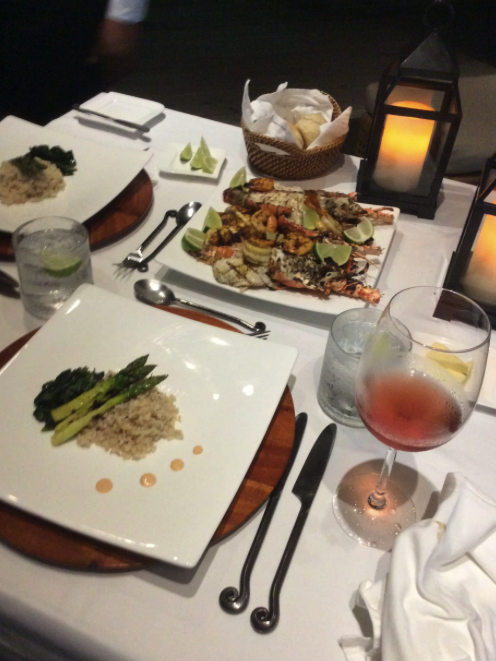On the hunt for conch, spiny lobsters and snapper on Belize’s barrier reef


By Eileen Ogintz
CAYO ESPANTO PRIVATE ISLAND, Belize — Snorkel masks on our faces, fins on our feet, we’re on the hunt in the clear, seven-foot water. Even though I’m in street clothes (thank goodness for quick dry!).
I wasn’t planning to swim, just relax and read a book while my husband fished for snapper. But here we are, looking for conch with our 22-year-old guide Carlos Cordova, who has been around boats all his life and diving since he was 10. Into the water we go and Carlos immediately free dives to grab one from the sandy bottom.
We are about six miles—a 20-minute boat ride—from the private island resort Cayo Espanto where we are staying, and as is customary, all of the activities are private—just for us.
As we hunt for the conch, we pass all varieties of tropical fish in the clear, warm water. We’re just at the edge of the immense barrier reef (second only to Australia’s and according to the Belizeans much healthier) that stretches for scores of miles along the Caribbean Coast (Belize is south of Mexico’s Yucatan Penninsula, east of Guatemala and north of Honduras).
Thus it is just my husband Andy and me, Carlos and our other guide Geronimo Teul who are both locals from San Pedro, the town and tourist hub on Ambergris Cay, Belize’s largest island and a 10-minute boat ride from where we are staying.
A bonus: Carlos spots spiny lobster hiding on the bottom. Using a hook, her catches two of the wily creatures who typically nestle under “tribes” made from corrugated tin and logs by fisherman. One scoots away—incredibly fast—but Cordova is faster and triumphantly grabs him too.

While my husband and Teul fish, ultimately catching a bakers dozen small snapper – yellow, mutton and red – Cordova gives us a lesson in making conch ceviche, the island’s most popular appetizer. “Everyone makes it differently,” he explains.
First, they get the conch meat from the distinctive pink and white shells (which go back in the water to make shelters for hermit crabs) and then cut off the meat in small pieces, soaking it in lime to “cook,” the fish (the waste goes back into the water as chum for the snapper). He adds peppers, onions, tomato and cilantro before adding spices – salt, pepper, a dash of Worcestershire sauce, maybe a little hot sauce. “Some like it more spicy, others less,” he says.

Some resort guests, he tells us, go out for an entire day, snorkeling, fishing, and conch hunting and end with have a BBQ at a nearby island. Belize has more than 100 islands.
When we’ve caught two conch big enough to keep (and feed a lot of people), we go back to the boat. “We don’t catch more than we need,” our two guides explain.
Cordova tells us he has been around diving and boats since he was a small boy and his mom was working at a family-owned hotel where the dive shop was located. He started lugging dive equipment, cleaning the bottom of the boats, graduating to driving the boats and becoming a dive guide. Now, like Teul, he works full time at Cayo Espanto.
“When we take people out,” he says, “we treat them like family—and Belizeans are very close to their families!” He still lives with his mom and dad—and his three dogs.

When we get back to the dock, the resort chef is waiting, suggesting how he will prepare our seafood feast—grilled lobster, snapper blackened and grilled.
“UnBelizeable,” says Cordova. “Belize in it!”
